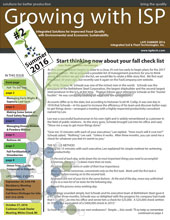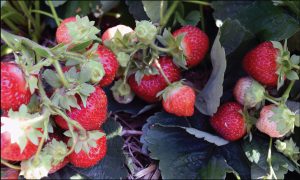

There are two important goals for optimum strawberry production, the first is setting a high fruit load potential, and the second is harvesting the maximum amount of the potential fruit set … maintaining both fruit size and flavor. June bearing strawberries set next year’s fruiting potential in the late summer and early fall. In addition, since early vigor during spring regrowth is essential for fulfilling the fruit potential and growing high quality berries, we must have a plant that goes into winter dormancy with high levels of nutrient and energy. (Everbearing and day neutral berries continually set fruit and are fertilized differently.)
In replicated trials this past season we’ve seen that strawberries respond very strongly to MetaboliK HV-1. We recommend 16 ounces per acre be applied either preplant or post planting. This can be applied in a variety of ways, although through the drip is probably the easiest. If you have second year berries, we apply 16 ounces per acre in both spring and fall.
 Plasticulture production of strawberries is becoming more common using plugs perhaps more so than bare root. Somewhat depending upon your location, planting may range from late July to mid-August. This offers a six to eight week window where the plants have to vegetate, increase crown numbers and initiate fruit … all within this rather short time frame prior to dormancy. Plant available nutrient supplied through fertigation increases your chances of success tremendously. Most of the comments concerning application of ISP plant foods is somewhat specific for plasticulture production and is given on a “per acre” basis.
Plasticulture production of strawberries is becoming more common using plugs perhaps more so than bare root. Somewhat depending upon your location, planting may range from late July to mid-August. This offers a six to eight week window where the plants have to vegetate, increase crown numbers and initiate fruit … all within this rather short time frame prior to dormancy. Plant available nutrient supplied through fertigation increases your chances of success tremendously. Most of the comments concerning application of ISP plant foods is somewhat specific for plasticulture production and is given on a “per acre” basis.
Concerning dry fertilizer application, general information indicates a recommendation of ½ pound of a balanced 10-10-10 be applied per 100 square feet either preplant or following renovation. This equates to about 200lbs per acre of fertilizer material, or the equivalent of 20lbs of actual nitrogen, phosphorous and potassium. Although okay from a general fertility standpoint, we don’t totally agree that this is all that’s necessary. We believe that there should be higher levels of nitrogen to build an aggressive frame, and more timely application of mineral nutrient to initiate and finish fruit. It is our belief that N should be applied following either renovation of your existing bed, or shortly after planting a new bed.
Nitrogen is of utmost importance in developing the vegetative frame, in both number and size of leaves, in order to capture a maximum amount of light. Or put another way, to maximize the potential of energy (sun-light) capture. In building the frame we are also increasing the number of crowns, where fruit is actually initiated. Discussing nitrogen, it takes from 40-60 units of nitrogen to grow the proper frame, and from our experience the variety Chandler will respond to even more, particularly at the northern edge of their growing zone. Approximately 20 units per acre of the major nutrients was supplied from the 10-10-10, which leaves us deficient at least 20 units of N, and probably more. Phosphorus, and certainly potassium, will also be deficient as initiating and/or setting fruit is primarily a mineral and energy function. Adequate P and K is important … secondary and trace minerals as well.
From about mid August to mid-October nitrogen should be fertigated at 3.5-6lbs per week depending on your harvest goals and planting quality. A combination of 28-16-7 and 10-20-20 (or 9-14-24) with micros is the ideal nutrient formula to provide not only nitrogen, but all other necessary nutrients as well, and this program is geared to reach our goal of 60 units of nitrogen.
Assume one acre using a split application of 28-16-7 and 10-20-20 to provide .75 of N per acre per day. Splitting the .75 pounds/per day nitrogen target between the two products would equal .375 pounds of nitrogen to come from each. Performing the math – .375/.28 = 1.34 pounds of 28-16-7 per day; and .375/.10 = 3.75 pounds of 10-20-20 per day. Again, this is based upon a “per acre” basis. For smaller plantings simply multiply the 1.34 pounds of 28-16-7 and 3.75 pounds of 10-20-20 by the fraction of an acre of your planting. Fertigation does not need to be done daily, and best results are obtained by splitting nutrient applications between two to three applications per week.
Stop feeding by mid-October, or about a month prior to covering, to allow the plants time to slow continuing growth and go dormant before winter. About a month before average dormancy date, apply 8-10lbs of 4-18-38. This will put the berries “to bed for the winter”, helping to ensure strong roots and crowns which will aid in reducing “heaving” of the crown and/or winter kill. This will also build strong crowns and roots, and a plant that will take off come spring.
